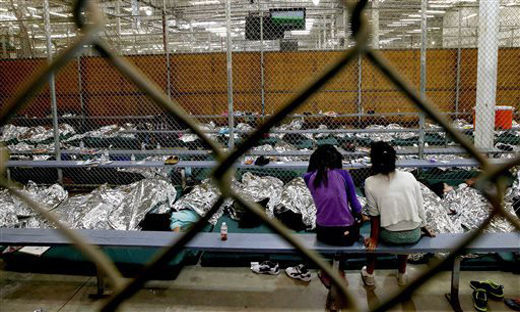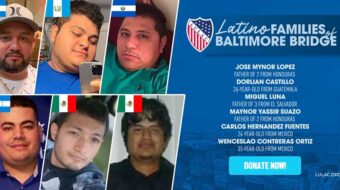
Thousands of unaccompanied child refugees from Central America, making their way through Mexico and into the U.S., are ending up in locked, fenced warehouses in Texas and Arizona.
To make matters worse the plight of these children ,who are sleeping on plastic boards and are often hungry and ill-clothed, is being cynically used by the right wing to further stymie any hope of immigration reform.
The anti-immigrant right is accusing the children, who by any reasonable standard are refugees from -horrific conditions in their home countries, of being nothing more than immigrants trying to “game” the system. The right wingers are saying the children want to take advantage of President Obama’s supposed “leniency” toward young immigrants and they’re saying no relief whatsoever should be given to any category of undocumented immigrants, including children.
The government is reporting a sharp increase in undocumented immigration on the U.S.-Mexican border, with a particularly large number of unaccompanied minor children crossing over. Most of the children are not from Mexico originally but from the poorer countries of Central America: Guatemala, Honduras and El Salvador.
Often, they are allowing themselves to be picked up by U.S. authorities. In spite of what the anti-immigrant right says, these children are not given a “free pass” to stay and are subject to deportation.
Meanwhile, the law requires that within 72 hours of being apprehended by the Border Patrol, the children have to be turned over to the Office of Refugee Resettlement to be placed either with their parents (if the latter live in the United States), or in a care facility until their immigration case is dealt with. But all facilities are now overwhelmed, and the federal government, in trying to open new ones, is running into “NIMBY” (“Not in my Back Yard”) opposition locally.
According to reports, the Border Patrol apprehended 162,000 immigrants from Mexico and Central America who tried to cross into South Texas without papers in the last 8 months. Forty seven thousand of these were unaccompanied minor children, some as young as four. The corresponding figure for the whole of 2009 was 3,304 children.
The National Association of Former Border Patrol Officers (NAFBO) suggested that because President Obama, with the Deferred Action for Childhood Apprehensions (DACA) program, suspended the deportation of young people who would be eligible for legalization under the DREAM Act, the United States is now being invaded by children hoping to “get on the gravy train.” However, this surge began before the announcement of DACA in June of 2012.
People who know Central America and who have interviewed the immigrant children assert that they should be seen as refugees rather than migrants, and that the crisis is a humanitarian and not an immigration one. The United Nations Commission on Human Rights representatives in the area say that 58 percent of the children certainly would qualify for relief under international law governing refugees.
The driving factors include, for some, a desire to rejoin parents who live in the United States. But more important is a sharp increase in violence and poverty in the Central American area.
Honduras and Guatemala have right wing governments who have cut back on basic services and under whom unemployment and poverty have increased. Honduras now has the world’s highest murder rate.
El Salvador just moved to the left with the election of Salvador Sanchez Ceren as president. However, it has been plagued for a long time by violent gangs or “maras” whose ultimate origin is in the United States: During the Salvadoran civil war of the 1980s, many people fled the violence and ended up in the poor barrios of Los Angeles and other U.S. cities. Some youths got sucked into gang activities which led to their being deported back to El Salvador. This jump-started the development of gangs there, which the Salvadoran government has had trouble controlling.
Mexican-based drug cartels have battled over turf with gangs in Central America or created links with them, creating a hyper violent situation in which the safety of ordinary working class or farming families has suffered greatly. There is an increase in kidnapping, extortion and violent robberies. This has contributed to an increase in the number of people of all ages who ride on top of “la Bestia,” not one but actually several freight trains which go from Mexico’s Southern border with Guatemala to its Northern border with the United States.
On the train they are no means safe; criminal gangs now frequently board to demand money . When they don’t receive it they often shoot people or throw them off the train, sometimes to their deaths. Women and girls are raped as a matter of routine.
Mexico, Belize, Nicaragua and Costa Rica also report increases in the number of Guatemalan, Honduran and Salvadoran unaccompanied minors who are crossing their borders. Mexico and Costa Rica are somewhat richer than the Central American countries. Nicaragua was for a long time one of the poorest countries in the region but has been doing better since hitching up with the “Bolivarian” group of left led countries led by Venezuela, through which it receives substantial aid.
In response to the crisis, Congress is working on providing more funds and President Obama has mobilized FEMA resources.
At writing, Vice President Joe Biden was headed for Central America to meet with the presidents of Guatemala, El Salvador and Honduras to “coordinate responses” and to explain to local people why it is dangerous for children to make the trek North, where they can be trafficked and otherwise preyed on.
What is needed is for U.S. politicians to ponder why it is so dangerous for them to stay.
Photo: Two young girls watch TV from a holding area where hundreds of immigrant children are being processed and held. Ross D. Franklin/AP

MOST POPULAR TODAY

Zionist organizations leading campaign to stop ceasefire resolutions in D.C. area


High Court essentially bans demonstrations, freedom of assembly in Deep South

Afghanistan’s socialist years: The promising future killed off by U.S. imperialism

Communist Karol Cariola elected president of Chile’s legislature






Comments